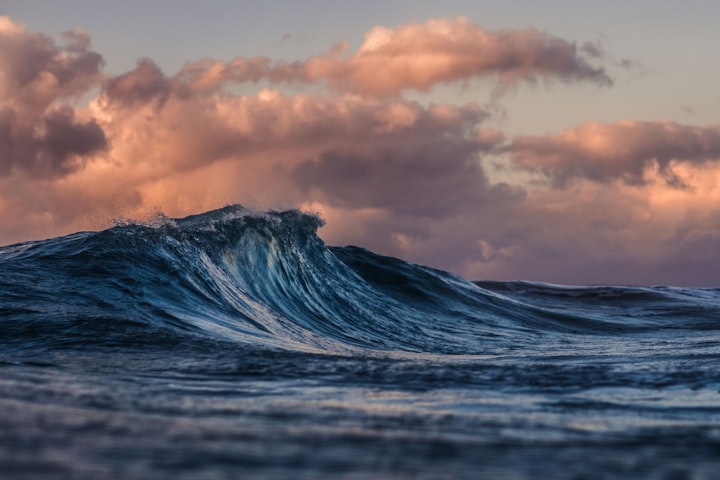Tsunamis In the North Sea - How Great Is the Danger?
Since 2004 we all knowhow devastating tsunamis can be. In Northern Europe we feel petty safe. Is that justified?

It was a catastrophe with 231,000 dead, and each of us still remembers the shocking television pictures that were broadcast on all channels at that time.
As much as this catastrophe shocked us in Northern Europe, it did not frighten us. We don't have any seaquakes that could cause such a calamity, we think. This article examines how safe we can really feel.
How Tsunamis emerge - Not every giant wave develops in the same way
There are several ways in which tsunamis can occur.
1. Seaquakes: To understand how a seaquake can lead to a tsunami, one has to remember what happens to the seabed in such an earthquake. In some cases, the accumulated tension of the tectonic plates discharges in such a way that the plates only shift horizontally.
In these cases, a seaquake does not lead to a tsunami. If, on the other hand, a vertical movement of the plates takes place, i.e., one slides jerkily under the other, a tsunami can occur because a massive column of water is set in motion. If the quake then takes place at a shallow depth and has a strength of more than 7, a tsunami sets in motion.
2. Underwater Volcanic Eruptions: It is easy to see how a submarine volcano can trigger a tsunami: An outbreak spits out gas and lava.
The water is thereby explosively displaced, and again we have the situation that a water column extending from the seabed to the surface starts to move in a ring. Not every underwater volcano triggers a tsunami. It always depends on the amount of material ejected in relation to the severity of the eruption.
3. Underwater landslides: Even when landslides occur on steep slopes below the sea surface, the mass of the moving material is large enough to displace enough water to cause a tsunami. Tsunamis of this kind can be absolutely devastating. We will see later that it is this variant that should concern us in Northern Europe.
4. Meteorite impacts: Are listed here for the sake of completeness only. They have already occurred in the distant past, but statistically, they are so rare that we do not want to worry about them here. How absolutely devastating tsunamis of this kind can be is beyond the imagination of most people.
Let us be glad that such an event has never occurred since time immemorial.
How frequent are tsunamis in the North Sea?
The last time that a tsunami hit the coasts of the North Sea was in 1858, with eyewitness accounts from Sylt, Helgoland, and Wangerooge. Apart from Germany, the shores of the Netherlands, France, England, and Denmark were also affected.
It is relatively sure that it was indeed a tsunami and not a spring tide because some details of the reports clearly point to characteristic features of tsunamis.
In particular, the accounts that the water withdrew from the coast before the wave arrived suggest a real tsunami.
A few hundred years earlier, in 1580, a seaquake occurred in the Strait of Dover that also triggered a tsunami. The wave hit the northern French city of Calais. One day later, another tsunami followed, which reached Normandy. This second wave is estimated to have had a height of up to fifteen meters.
The most massive tsunami disaster known from the North Sea to date occurred 7,000 - 8,000 years ago. Under the name "Storegga event," it has entered the scientific literature.
The continental slope off Norway slipped over a length of 800 kilometers. Over 5,000 cubic kilometers of material began to move and triggered a violent tsunami that struck England, Scotland, and Norway.
The reason for this massive landslide is thought to be a destabilization of the slope by defrosting methane hydrate. This frozen methane hydrate still gives the continental slope its hold today. When it melted back then, it led to disaster.
Could there be another tsunami in the North Sea?
Many experts today believe that the North Sea is too shallow to create a tsunami of threatening proportions. They argue that the wave would already break far off the coast.
In his novel "The Swarm," Frank Schätzing describes precisely the scenario that took place 8,000 years ago at the Storegga event, only that he shifts such a catastrophe into our time. So what is to be expected from such disaster scenarios?
Without being a scientist yourself, it is difficult to find a plausible answer. But if one considers that the publications of the studies, which think a tsunami in the North Sea to be impossible, date from 2006, it is worth taking a look at the press of the following years.
On 7 April 2012, the German news magazine Der Spiegel reported on two researchers who warned of the danger that something like this could actually happen today.
The scientists have evaluated numerous references to the 1858 tsunami and the Storegga event. Especially the tsunami of 1858 makes such a scenario seem plausible even today. The North Sea was then no deeper than it is today and yet the coasts were rolled over.
If you look more closely at the argument that the North Sea is too shallow for a severe tsunami, you will see that the issue is missing the point.
Northern European harbors may not have to fear a wall of water over thirty meters high, but that is not even necessary to trigger a disaster. Anyone who has seen the television pictures of the 2004 tsunami knows that a tidal wave six to ten meters high is enough to devastate a coastal region far inland.
The water column set in motion by a possible seaquake or landslide will nevertheless push towards the coast and roll over it. Whether the wave breaks far off the coast plays a subordinate role.
It remains to be seen how a landslide of the order of 8,000 years ago could occur today. The methane hydrate that holds the slope together appears to be stable at present.
However, the progressive warming of the oceans can give cause for concern. It is quite conceivable that climate change could pose a further threat to humanity that has not yet been sufficiently addressed.
Receive weekly email and don’t miss any of my articles.
suscribe here http://bit.ly/ReneJunge
I confirm that I am the author of the article and that I have the relevant rights to submit this story to Vocal.
About the Creator
René Junge
Thriller-author from Hamburg, Germany. Sold over 200.000 E-Books. get informed about new articles: http://bit.ly/ReneJunge






Comments
There are no comments for this story
Be the first to respond and start the conversation.